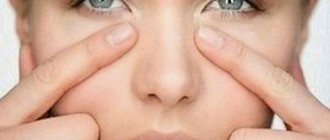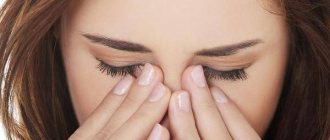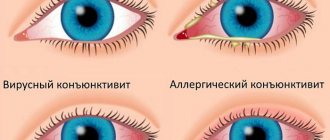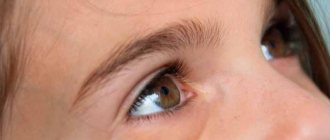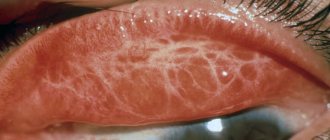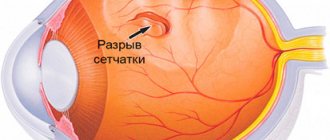How and why do facial swelling appear?
In the body of a healthy person, the amount of fluid is about 70% of body weight. Of these, 1/3 is located outside the cells (interstitial fluid) and provides the elasticity of the soft tissues of the skin. Visible swelling appears when there is excess fluid in the body, reaching more than 2 liters or local edema after damage to soft tissue vessels.
Causes
The increase in the volume of intercellular fluid mainly appears due to sodium retention and excess water in the body. However, this does not happen in healthy people, thanks to the balance of blood circulation and the well-coordinated functioning of the lymphatic system.
The release of fluid into the intercellular space is facilitated by an increase in hydrostatic pressure in the capillaries and its decrease in the tissues, increased capillary permeability, protein deficiency in the blood, lymph stagnation, and a decrease in oncotic and/or osmotic pressure in the blood.
These violations are typical for:
- pathologies of the heart, liver, kidneys;
- allergic reactions;
- hormonal dysfunctions (endocrine diseases, pregnancy, premenstrual syndrome);
- gastrointestinal diseases (malabsorption syndrome);
- superior vena cava syndrome;
- cervical osteochondrosis;
- kwashiorkora;
- inflammatory processes on the face (phlegmon, erysipelas, pyoderma).
Often the cause of edema is an incorrect lifestyle or household factors:
- intoxication of the body (alcohol, parasites, food, chemicals, insects);
- use of medications (NSAIDs, glucocorticosteroids);
- excessive sodium intake;
- protein or complete fasting;
- skin injuries (bruises, burns);
- surgical interventions, salon procedures;
- long-term insolation;
- excessive consumption of hot, spicy, fatty foods;
- lack of sleep, oversleeping.
Facial swelling often appears in old age, even in the absence of concomitant diseases. This is explained by age-related wear and tear of many body structures, in particular the myocardium (heart muscle), blood vessels, and urinary system.
Why do swelling appear more often in the morning?
Most often, swelling of the face can be observed after waking up. This is explained by a slowdown in metabolism in the body, stagnation of venous blood after a prolonged vertical position of the body, natural nocturnal acidosis (decrease in blood pH), and possible disruption of the outflow of venous blood due to an uncomfortable position of the head.
In healthy people, the cause of morning edema may be excessive consumption of fluid or foods that promote fluid retention.
When excluding these factors, some of the most common causes are too high a pillow, unnatural posture, lack of sleep and oversleeping.
Symptoms and signs of facial swelling
Swelling, which appears as a result of overwork, alcohol consumption, and poor quality sleep, is mainly expressed in the morning and is localized in the eye area. In healthy people, they go away without treatment as the body heals itself.
Swelling that appears after injuries, cosmetic procedures and other factors for which this process is normal does not cause concern.
It is important to pay attention to additional signs in which only seeking medical help will prevent serious complications.
Hormonal disorders are characterized by the development of swelling of the upper and lower eyelids, general puffiness of the face, pallor, dryness and low skin temperature. The swelling is dense. The skin cannot be gathered into a fold; when pressed, there is no dimple left.
Cardiac edema initially appears in the lower extremities with subsequent spread to the tailbone, arms and face. The main location on the face is the eye area. Cardiac edema is accompanied by shortness of breath, cyanosis (blue discoloration) of the lips, pale skin, tachycardia, and fatigue.
Renal edema forms while the patient sleeps. They are characterized by severity in the morning, initial appearance on the eyelids with subsequent spread over the face and lower parts of the body. Additional symptoms: foamy urine (proteinuria), lower back pain and general weakness.
Swelling of the face in combination with yellow skin color, attacks of nausea and vomiting, headache and fever signals liver disease. Basically, these symptoms appear only in advanced stages of pathologies.
Swelling that appears as a result of gastrointestinal diseases covers the entire face, is persistent and soft to the touch. Often accompanied by diarrhea, nausea, vomiting and abdominal pain.
In allergic reactions, the main danger is angioedema. It is characterized by rapid development, involvement of subcutaneous fatty tissue and mucous membranes in the pathological process.
Main locations: lower lip, cheeks, larynx, eyelids, tongue. It is characterized by the absence of changes in skin color, tissue tension, painlessness on palpation and blue tongue. The patient has difficulty speaking and breathing.
In any case, the alarming factors should be the persistence of facial swelling during the day and its appearance in the evening hours against the background of general malaise. All the described signs are a reason to contact a therapist and conduct a general examination of the body.
Why does the right side of the face swell after sleep?
Swelling on the right or left side indicates local problems. If, due to diseases of the cardiovascular system and respiratory organs, the entire face swells, then swelling in only one part of the face indicates that there is damage to a specific zone located in this area.
Why does the right side of the face swell after sleep?
- Insect bite, allergic reaction
- Ear or sinus problems
- Dental diseases, caries and suppuration
- Inflammation of the trigeminal nerve
- Neurological ailments
- Osteochondrosis of the neck in a certain area
Usually, in order to get rid of such swelling, you need to consult a doctor and find out the exact cause. If the face swells on only one side, then local treatment is necessary. This has nothing to do with drinking salt, drinking a lot of fluids, or eating before bed. To get rid of swelling that is caused by improper sleeping position or drinking large amounts of liquid, it is enough to make a few simple masks.
Edema
Diagnostics
Diagnosis begins with assessing the clinical picture and collecting anamnesis. The doctor clarifies the time of occurrence, frequency and persistence of edema, the presence of additional subjective sensations, basic lifestyle and dietary habits.
Based on the examination, the patient is referred to the appropriate doctors. Depending on the suspicion of a particular pathology, different diagnostic methods are used.
Research:
- general blood and urine tests;
- blood chemistry;
- blood test for hormone levels;
- determination of the level of brain natriuretic peptide;
- ECG, echoCG;
- radiography, computed tomography;
- allergy tests;
- fibrogastroduodenoscopy;
- Ultrasound of internal organs.
Each reason leading to the appearance of swelling on the face has its own specifics and requires targeted treatment of pathologies of internal organs.
Principles of treatment of edema in various diseases and disorders
In cases where pathologies of internal organs are diagnosed, patients are prescribed etiotropic treatment, which includes the elimination of edema. The goals of decongestant therapy are to remove excess fluid from the body, improve general and local hemodynamics, and regulate lymph flow in the edematous area.
Diuretics
Diuretics stimulate the formation of urine and its subsequent excretion from the body. This helps reduce excess fluid in the body and quickly eliminate facial swelling. The drugs are used for renal, cardiac, and hepatic edema of the face as prescribed by a doctor.
Diuretics:
- aldosterone antagonists (Spironolactone, Aldactone, Veroshpiron);
- sodium ion channel blockers (Triamterene, Triamtezid, Diutak, Fluxinar);
- thiazide diuretics are used in combination with potassium preparations (Indapamide, Dichlorothiazide, Chlorthalidone);
- loop diuretics (Torasemide, Furosemide, Bumetanide, Piretanide, ethacrynic acid);
- carbonic anhydrase inhibitors (Diacarb, Diuremide, Glaupax, Renamide).
The choice of drug, dosage and duration of treatment depend on the specific pathology and general treatment tactics.
Diuretics are useless for eliminating edema caused by purulent-inflammatory and allergic processes, mechanical compression of venous vessels due to tumors, skin damage due to burns and injuries.
Allergic edema
Elimination of this type of edema is possible only after complete elimination of the allergen from the body. For this purpose, a hypoallergenic diet is prescribed, contact with household and epidermal allergens is limited.
In severe cases, desensitizing therapy is prescribed. This is the removal from the body of mediators of allergic reactions, immunocomplexes, metabolite products of parasites and toxins. To do this, 10% solutions of calcium chloride, calcium gluconate or sodium thiosulfate are injected into the patient’s body.
Antihistamines are prescribed:
- Tavegil;
- Pipolfen;
- Loratadine;
- Diazolin;
- Telfast;
- Zyrtec.
For allergic dermatoses, lotions with a 5% solution of boric acid, a 5% solution of resorcinol, and chlorhexidine will help temporarily eliminate swelling.
First aid for angioedema of the face
This is an extremely dangerous condition that can be fatal without emergency help. Therefore, if characteristic symptoms appear, you need to call an ambulance team.
Before the doctors arrive you need to:
- eliminate the source of the allergen;
- put the patient on his back, raise his legs;
- clear the airways;
- If there is no pulse or breathing, perform an indirect cardiac massage.
To relieve swelling, the patient is injected intravenously with a 0.1% solution of adrenaline, hormonal drugs (hydrocortisone, dexamethasone, prednisolone), and antihistamines (ranitidine, diphenhydramine). For mild anaphylaxis, any oral antihistamine can be used.
For intestinal diseases
Facial swelling associated with disorders in the intestines mainly occurs in pathologies during which a large loss of protein occurs. These are intestinal lymphangiectasia, tumors in the small intestine, Will's disease, sprue syndrome.
In addition to etiotropic treatment, the patient is prescribed:
- protein enpits;
- amino acid preparations;
- vitamin and mineral complexes;
- probiotics;
- enzymes.
During treatment, the patient adheres to a high protein diet.
Edema with osteochondrosis
Facial swelling with osteochondrosis appears due to hemodynamic disturbances (blood stagnation). This occurs due to mechanical compression of the vessels after displacement of the intervertebral discs or muscle tension. Edema can be completely eliminated only by curing osteochondrosis.
To temporarily eliminate edema, the following are prescribed:
- microcirculation correctors (Trental, xanthinol nicotinate);
- muscle relaxants (Mydocalm, Sirdalud, Baclofen);
- diuretics with a vasodilating effect (Diuretin).
Additionally, acupuncture, physical therapy and massage are used.
Superior vena cava syndrome
The basis for the development of the syndrome is extravasal compression (compression) and thrombosis of the superior vena cava, leading to disruption of the outflow of venous blood from the upper half of the body. This leads to swelling and cyanosis of the face, attacks of suffocation and shortness of breath.
The complex of basic therapy consists of taking anticoagulant and fibrinolytic agents, surgical treatment for congenital anomalies. To relieve stress from the body and relieve swelling, the patient is prescribed diuretics.
For kwashiorkor
The cause of the development of the disease is protein deficiency, in combination with a deficiency of nutrients and energy consumed by the patient.
The main method of treatment is to eliminate protein deficiency with the help of foods, protein enzymes, and amino acid preparations. Additionally, vitamin A and B vitamins and enzymes are prescribed.
In case of intoxication
In this case, the patient is prescribed detoxification therapy. First of all, this means stopping the entry of toxin into the body, washing the stomach and intestines, and cleaning the mucous membranes and skin.
Medicines:
- enterosorbents (Enterosgel, Smecta, activated carbon);
- diuretics and laxatives;
- antidotes for acute poisoning (Unithiol, Nalorphine, thetacin calcium, tocopherol acetate, methylene blue).
In severe cases, the patient is recommended to undergo blood delysis.
In inflammatory processes
Viral and bacterial infections of the ENT organs, skin, teeth and gums are always accompanied by acute inflammation, leading to swelling of the face.
Non-steroidal anti-inflammatory drugs, antibiotics and antiseptics are used for their treatment. Lotions and compresses made from herbal remedies will help temporarily eliminate swelling.
Facial swelling during pregnancy
The appearance of edema during pregnancy is associated with the activity of the hormones progesterone and estradiol, leading to destabilization of water-electrolyte metabolism and fluid retention in the body.
An unfavorable sign indicating serious complications is persistent and severe swelling of the face.
For treatment use:
- antihypertensive drugs;
- antiplatelet agents (prevention and elimination of thrombosis);
- diuretics;
- medicines to strengthen vascular walls;
- mineral and vitamin complexes.
Additionally, a diet high in protein and nutrients and an optimal drinking regimen for pregnancy are prescribed.
Hormonal edema
For persistent complication of premenstrual syndrome by edema, diuretics and drugs that suppress the synthesis of the hormone estrogen (progestin, progesterone) are used.
Edema due to pathologies of the endocrine system is eliminated only after etiotropic treatment of hormonal dysfunction. For severe edema, leading to a heavy load on the internal organs, diuretics are prescribed.
Swelling after burns
The formation of edema after burns is caused by local dilation and damage to blood vessels, protein coagulation, inflammatory processes, circulatory and microcirculation disorders.
For severe swelling after burns, medications are used in the form of an ointment or aerosol:
- Panthenol;
- Olazol;
- Levomekol;
- Traumeel;
- Dolobene;
- Biopin.
Aerosols are sprayed from a distance of 10-15 cm, ointments are applied in a thin layer to the surface of the affected area. Depending on the drug, the procedure is carried out 1-3 times a day.
Post-traumatic swelling and bruises
With bruises and impacts, damage to microvessels and capillaries occurs. In soft tissues, hemorrhages occur and fluid leaks into the intercellular space. A hematoma forms in the affected area, it begins to swell and spread over a large area.
To quickly get rid of the consequences of injury, drugs with decongestant, anti-inflammatory, and angioprotective properties are used.
Medicines in the form of ointments, gels:
- Troxevasin;
- Badyaga;
- Heparin gel;
- Traumeel;
- Fastum gel;
- Lyoton.
With excessive swelling, the irritating effect of iodine will be useful, promoting rapid resorption of the hematoma. To do this, a day after the injury, you need to make a mesh from a 5% iodine solution.
Postoperative
Swelling after any facial surgery is a natural phenomenon, isolated from damage to small vessels and impaired microcirculation.
To reduce postoperative swelling and hematomas, you need to follow a number of simple rules:
- applying cold compresses (ice cubes, cryopacks) to the swelling every 2 hours;
- positioning the head at a lower level relative to the legs during sleep;
- reducing fluid and salt intake;
- limiting physical activity that leads to a rush of blood to the tissues;
- exclusion of coffee and alcohol consumption.
For residual edema, which is observed 3-4 weeks after surgery, medicinal ointments are used: Troxevasin, Badyagu, Traumeel.
Swelling in the eye area
The skin and soft tissues around the eyes are characterized by the presence of a large number of small vessels and the loose structure of subcutaneous fatty tissue, therefore they are most susceptible to fluid accumulation.
Local swelling in this area can be caused by the accumulation of fluid in the lacrimal gland, wearing incorrectly fitted lenses, dirt getting into the mucous membranes, and inflammatory eye diseases.
For the treatment of edema the following is used:
- diuretics after consultation with the doctor;
- decongestant patches Ekstraplast, Lusero 2 times a week;
- for inflammation, medications: Neladex, Opatanol, Blefarogel, Floxal ointment;
- eye drops Visin, Naphazoline, Phenylephrine;
- lotions with infusions: chamomile, calendula, sage.
It is recommended to constantly cleanse the skin around the eyes with herbal antiseptics and use moisturizers with collagen or caffeine. To strengthen the skin, twice a week you need to make compresses with oils containing chestnut, vitamin K, and hyaluronic acid.
After drinking alcohol
The appearance of edema after drinking alcohol is due to severe intoxication of the body. It can occur after excessive consumption of alcohol or from small doses under the influence of fusel substances formed during the fermentation of alcohol.
At the same time, a complex of pathological processes occurs in the body - increased diuresis, a decrease in the volume of circulating blood, a lack of fluid in the vessels and its accumulation in the tissues. Edema of this etiology can be eliminated only with complex treatment of a hangover; external medications are useless in this case.
Treatment begins with restoring the water-salt balance. To do this, use mineral water containing magnesium, lactic acid products, cabbage or cucumber pickles, and natural kvass.
Drinking plain water is not recommended; if there is a deficiency of electrolytes, it is perceived by the nervous system as excess liquid and is quickly eliminated from the body.
Enterosorbents are used to remove toxins from the body:
- Smecta;
- Pipolfen;
- Enterosgel;
- Activated carbon.
The drugs are taken in 2 tbsp. l. every 2 hours.
To neutralize toxins, use succinic acid, 1 tablet every 2 hours. To expand the skin pores and speed up the removal of toxins through them, take a hot shower for no more than 15 minutes.
With this treatment, toxins and fluid accumulated in the tissues are gradually eliminated from the body. Facial swelling is completely eliminated within 12 hours.
The author of the video shares his recipe for relieving swelling on the face using Lyoton gel.
Cosmetic procedures
To treat facial edema, cosmetic procedures are used to improve the functionality of local microcirculation and blood circulation.
Lymphatic drainage massage
This is a specially developed method of influencing soft tissues and blood vessels using a manual or hardware method, stimulating lymph circulation. After a course of procedures, lymph flow and blood circulation in the face and neck are activated, muscle tone is normalized.
A massage course includes 10-15 procedures. After complete recovery, it is recommended to undergo courses of maintenance procedures every 6 months.
The results of the massage are complete elimination of swelling on the face and bags under the eyes, optimal water-lipid balance in skin cells, tightened skin and a healthy complexion.
Darsonvalization of the skin
The basis of the method is the effect on skin tissue of high voltage alternating current supplied through an electrode filled with gas. The anti-edematous effect is achieved by stimulating the outflow of venous blood and accelerating local metabolism in the subcutaneous layers.
To achieve a lasting effect, 10-20 procedures will be required. After treatment, swelling, fine wrinkles are eliminated and skin turgor is restored.
Hardware myolifting
During the procedure, the facial skin is exposed to microcurrents in combination with special products containing vitamins and microelements. Electrical current pulses stimulate muscle contraction and affect nerve endings.
As a result, the outflow of lymph is normalized, the walls of blood vessels and skin cells are toned, and toxins are eliminated.
A persistent anti-edematous effect is achieved after 10 procedures performed at intervals of no more than 3 days.
Face lift
This term combines cosmetic procedures for skin tightening, performed surgically or non-surgically. After face lifting, the functionality of microcirculation, blood circulation and lymph flow in the subcutaneous layers is restored.
Methods:
- circular facelift;
- endoscopic lifting;
- thread lifting;
- hardware lifting (radio wave, ultrasound, laser);
- plasmalifting.
The choice of procedure depends on the age, individual condition of the skin and the human body.
Mesotherapy or Botox
During the procedure, individually composed cocktails are injected into the skin layers using thin needles. To achieve an anti-edematous effect, the meso-cocktail includes substances that regulate lymph flow and blood circulation: vitamins, minerals, veno- and lymphotonics.
The course of treatment consists of 10 procedures. On average, the effect of mestherapy and Botox is observed for 6 months.
Remedies
Edema can and should be fought. The reason that caused them plays a huge role: if possible, it must be eliminated (for example, stop eating too salty foods or not drinking alcoholic beverages). There are also other methods to eliminate swelling.
Salon treatments
In order to eliminate swelling on the face, modern procedures have been developed, which are carried out in beauty salons by specially trained people. Before using them, you should definitely consult with a cosmetologist in the salon, who will identify possible contraindications to these procedures.
At the moment, the following methods have proven effectiveness and are in high demand:
- Mesotherapy – special preparations are injected into the skin to saturate the skin with vitamins and other beneficial substances. Metabolism improves, so the removal of excess fluid improves. Facial swelling is eliminated. To obtain a visible and long-lasting effect, one procedure is not enough: you need to visit the salon once a week, and the duration of the course is determined by the doctor (several months).
- Cryolifting is a rejuvenation technique. The skin is briefly exposed to extremely low temperatures. The effect of the procedure is noticeable almost immediately and lasts for a long time, which is why it is popular.
- Wraps and mud masks. With these procedures, the skin becomes more elastic and smooth. When wrapping, a person warms up and sweats, excess liquid is removed.
Diuretics
The use of any medications is advisable only after consulting a doctor. Diuretics are indicated only in cases where swelling affects the patient’s quality of life and health:
- Swelling on the face does not go away within a few days and tends to spread.
- Swelling leads to the fact that the palpebral fissure decreases in size, which is why vision is impaired. In severe cases, this can result in displacement of the eyeball.
It is important to understand that diuretics are only a temporary measure: they can remove the external manifestations of swelling, but they cannot cope with its cause. Therefore, after stopping diuretics, there is a high probability that they will occur again. They also have many side effects, among which the most common are water-electrolyte imbalance and loss of ions (potassium, calcium and others).
Masks
On store shelves there is a huge selection of masks to eliminate puffiness on the face. By providing a local effect, they can quickly cope with swelling, in addition to toning the skin and giving it a healthy and rested appearance. Face masks can also be made at home from natural ingredients.
Recipes for some of them:
- Potato mask. You can use both raw and cooked root vegetables. To prepare a hot mask, you need to boil the potatoes, mash them and apply them to your face. Keep the potatoes on your face for no more than 15 minutes, after which you need to rinse with warm running water. When making a mask from raw potatoes, you need to grate them into a paste.
- Pumpkin. To do this, boil the pumpkin until mushy, and add just a little honey (half a teaspoon). The resulting mass should be placed on gauze and applied to the swollen area for 20 minutes.
- Cucumber-lemon. This mask effectively fights morning puffiness, giving the skin a rested and well-groomed look. Grind the cucumber using a blender and add a tablespoon of lemon juice. Apply this mixture to your face in the morning, and after 20 minutes, rinse with warm running water.
Massage
In youth, to eliminate morning puffiness, you only need a little time, a light facial massage or applying a moisturizer. But at an older age (after 35 years) you need a professional massage using cosmetics, which can speed up metabolism and collagen synthesis in the facial skin.
At a young age, a light massage and the use of moisturizers are usually enough to make the swelling disappear. Over time, a more professional massage will be required using special techniques and auxiliary products, which will accelerate metabolism and collagen synthesis in tissues.
Lymphatic drainage facial massage shows good effectiveness. The movements are directed along the lymphatic vessels, as a result of which its outflow from the tissues improves. The result is noticeable even after the first session, and a course of massage helps get rid of unhealthy complexion and fine wrinkles. With edema, the fluid in the vessels stagnates, and harmful substances accumulate in it.
By restoring normal circulation, the elimination of toxins is improved, resulting in a fresher appearance. The duration of one session should not exceed 10 minutes, and the course consists of approximately 10 techniques. You definitely need to listen to your body and avoid excessive tension on the skin, which is especially delicate around the eyes.
Compresses
If the cause of swelling lies in a late-night feast or drinking heavily before bed, then you can eliminate it with the help of compresses. Funds for them can be found in every home.
- You can wipe your face with an ice cube. To do this, you need to freeze plain water or a decoction of chamomile, sage or plantain in the evening. These herbs have an anti-inflammatory effect and relieve swelling.
- Contrast compresses give excellent results, relieving a woman of swelling. A napkin or gauze soaked in hot water and then in cold water is applied to the face. The napkins need to be changed several times (5-6).
- Compresses with a tea bag. You need to first brew the tea in hot water, after which the bag is sent to the freezer to cool for a few minutes. Apply to swollen areas before heating.
Folk remedies for edema
Traditional medicine is often used to eliminate facial swelling. They are distinguished by the availability of components, fast and safe action for the body, and additional beneficial properties for facial skin.
Face masks
To prepare masks, components are selected that can draw fluid from tissues, stimulate metabolism and blood circulation.
Recipes:
- Cucumber.
Add lemon juice (1/2 tsp) or olive oil (1 tbsp) to the vegetable crushed to a pulp (1 pc.) and mix. The mixture is applied to the face and left for 30 minutes.
- Pumpkin.
Pumpkin pulp (100 g) is poured with water (100 ml) and boiled until softened. Add honey (1 tsp) to the cooled pulp and mix. A gauze cloth is applied to the face, the mixture is applied, covered with plastic wrap and left for 20 minutes.
- Potato.
Raw vegetable (1 piece) is grated on a fine grater, wheat or buckwheat flour (1 tbsp) is added to the gruel. The mixture is applied to the face and left for 30 minutes.
- Parsley and dill.
Grind a bunch of greens in a blender, add low-fat sour cream (2 tbsp.). The mask is applied to the face and left for 15 minutes.
- Apple.
The middle fruit is peeled and grated on a fine grater. The paste is applied to the eyelid area and left for 15 minutes.
- Coffee beans.
Ground grains (10 g) are mixed with natural yoghurt (2 tsp) and softened. The mixture is applied to the face and left for 10 minutes.
To increase the effect of decongestant masks, they are washed off with a cool infusion of herbs: calendula, sage or chamomile. The face is blotted with a soft towel.
Compresses and lotions
Compresses work faster than masks, so they are indispensable when time is limited or swelling suddenly appears before important events.
Brine
One of the fastest ways to eliminate facial swelling. Because salt can cause damage to skin cells, it is only used when absolutely necessary.
To prepare the solution, table salt (2 tbsp) is dissolved in hot water (1 l). A terry towel is soaked in the solution, wrung out and applied to the face. To reduce evaporation, apply a dry towel on top and hold until dry.
The procedures are carried out 2-3 times. After this, the face is washed with cool water and a moisturizer is applied.
Medicinal ice with herbs
This method is convenient for daily use in the morning. To make ice you will need a mold and medicinal herbs.
Dry herbs:
- chamomile;
- calendula;
- sage;
- linden flowers;
- arnica;
- series.
To prepare the product, the selected herb (1 tablespoon) is poured with boiling water (250 ml) and left for 1 hour in a thermos. The strained infusion is poured into an ice tray and frozen.
To relieve swelling, ice cubes are wrapped in thin cloth and applied to problem areas. These infusions can be used for lotions and applications.
Tea compress
Disposable tea bags are doused with boiling water and placed in the freezer for 10 minutes. Cooled bags are applied to the eye area for 10-15 minutes. If possible, the procedure is repeated 3-4 times.
Cabbage leaves
Before use, cabbage leaves are immersed in boiling water for 5 minutes to soften. After this, lemon juice is sprayed onto the leaf or coated with a thin layer of honey.
Leaves are applied to swollen areas of the face for 30 minutes. In cases of complete swelling of the face, use cabbage leaf pulp mixed with honey or olive oil 2:1.
Diuretic teas and infusions
Products based on diuretic herbs are distinguished by their mild action and relative harmlessness to the body. Additionally, they tone and supply the body with nutrients.
Recipes:
- Rose hips (50 g) are poured with boiling water (1 l) and infused in a thermos for at least a day. Take 3 times a day, 200 ml.
- A mixture of birch leaves and horsetail, mixed equally (2 tablespoons), is poured with boiling water (0.5 l) and left for 30 minutes. Take 100 ml 3 times a day.
- Elderberry, blackthorn leaves, birch leaves, and nettle are mixed in equal proportions. The collection (1 tablespoon) is steamed in boiling water (250 ml) and boiled for 15 minutes. The strained decoction (200 ml) is taken before breakfast.
- Mix beetroot and cranberry juices in equal parts. Take 100 ml 3 times a day.
- Crushed lingonberry leaves (1 tbsp) are infused in boiling water (250 ml) for 1 hour. Take 50 ml 3 times a day.
- Finely chopped mint leaves (2 tbsp) are poured with boiling water (0.5 l) and left for 20 minutes. Take 200 ml 3 times a day.
Dandelion leaves, burdock root and leaves, yarrow, elderberry flowers, wheatgrass, bearberry, barberry, and fennel have mild diuretic properties. These herbal ingredients can be brewed as tea. For this, 1 tsp. dry raw materials are brewed in a glass of boiling water and left for 7-10 minutes.
Herbal diuretics are used warm for up to 16 hours, separately from food. The course of treatment is no more than 1.5 months. Resumption of use is possible only after a break of 2-3 weeks.
Contrast wash
Alternate exposure to hot and cold water causes subcutaneous vessels to contract and expand, stimulates metabolic processes, blood circulation and microcirculation. The procedure is carried out in the morning after warming up exercises or massage.
Rules of procedure:
- rinsing your face with warm water 3 times (for preparation);
- switching water to hot mode, rinsing 10 times;
- switch to cold water, rinse 5 times;
- repetitions of hot and cold stages;
- The duration of the procedure is 10 minutes.
Contrast washing always starts with hot water and ends with cold.
The duration of exposure to hot water should be longer than cold. After washing, massage the face with a soft towel and apply a softening cream. You can go out into fresh air after 1 hour.
Daily gymnastics
Activity after waking up stimulates the outflow of excess fluid from the face, helping to quickly get rid of swelling. Movements in a vertical position create natural conditions for the distribution of fluid throughout the body.
First of all, you need to relieve tension from your neck:
- place one hand on the chin, the second on the collarbone, tilt the head in different directions, stretching the muscles;
- one hand is located under the back of the head (fixing the muscle), the other lightly presses on the neck and makes movements in a downward direction.
- in a standing position, stretch your arms down, slightly raise them, tilt your head back, and pull your chin up.
Each exercise is done 10 times.
After this, they begin facial gymnastics, the anti-edematous effect of which is achieved by changing muscle tension and relaxation. Exercises are performed while sitting on a chair in front of a mirror:
- Open your eyes wide and count to 10, close your eyelids and relax.
- After this, they make 8 circular movements with their eyes, looking left, right, up, down several times. Repeat 2-3 times, with intervals of 15 seconds between them, relaxing the eyelids;
- Close your eyes and count to 10, relax your eyelids and count to 5. 3-4 repetitions.
- Use your fingertips to press the area of skin under your eyes, close your eyes and count to 5. The finger pressure is gradually relaxed. Repeat 2 times.
- They press the outer edges of the eyebrows with their fingers, overcoming resistance, slowly close their eyes, count to 10 and relax the muscles. Repeats 3-4 times.
- Place your elbows on the table, press your palms to your cheekbones without moving the skin, apply pressure and count to 10. Relax your muscles. Repeats 2-4 times.
These simple exercises take no more than 15 minutes and promote stable blood circulation and metabolism. The skin of the face is noticeably tightened, fine wrinkles are smoothed out, and swelling is less of a concern.
Decongestant massage
For people prone to facial swelling, cosmetologists recommend taking the first course of massage from a specialist. In this case, you can visually see the technique of the procedure and feel the force of the required impact.
Home massage method:
- Conventionally, points on the face are indicated: in the center of the chin (1), on the top of the cheekbones (2 and 3), above 2 cm above the middle of the eyebrow line (4 and 5);
- after that, alternately press on these points, repeat 10-15 times;
- With your middle fingers, lightly press on the outer corners of your eyes and slowly draw a line to the bridge of your nose;
- smoothly move to the area under the eyebrows, make tapping movements, return the fingers to the outer corners of the eyes;
- re-draw the line to the bridge of the nose and repeat all movements, but under greater pressure;
- The entire massage complex is repeated 3 times.
To enhance the effect, before the procedure, the skin is moistened with a decoction of parsley, dill or other decongestant herb.
How to remove
In order to remove swelling from the face, you can start using natural infusions and decoctions of parsley, calendula, celery, and chamomile. Blueberry and lingonberry leaves help lower blood glucose levels.
Ways to remove puffiness from the face and eyes in the morning:
- Immediately after waking up, drink a glass of water with a few drops of lemon juice added to it. This will activate the work of internal organs and relieve swelling.
- You can do a special massage. Starting from the forehead, massage the skin with tapping movements (with strong pressure). Near the eyes and temples, tapping with fingertips should be light. After the massage, the swelling will quickly subside.
- Compress. Soak a small towel in very cold water and place it on your face. Make a compress for 10 minutes, periodically wetting the towel in cold water.
- Potato. Boil 3-4 potatoes depending on the size, drain the water, cool (the potatoes should be warm), mash and immediately apply to the swelling for 11-12 minutes. Rinse off with cold water. The mask is made once a day, the course is on average 10 procedures.
- raw potatoes (2 medium-sized pieces) together with their skins on a fine grater, add 20 g of oatmeal. Apply a thick layer to your face and place gauze or cloth on top. You need to lie down with this mask for 1.5-2 hours.
- Bay leaf will help if swelling is caused by increased salt intake. Brew 5 leaves with 200 ml of boiling water, let it brew for 1 hour. Dip a towel or cloth into the solution and apply to your face. The effectiveness will increase if you drink 1 tbsp twice a day. spoon of this infusion.
- Rosehip decoction has a tonic and diuretic effect.
Place 9-15 rose hips in an enamel bowl, add 750 ml of water (3 cups) and boil for 14 minutes. Drink in small sips, you can add a little honey. The duration of the course is a maximum of 12 days, then you need to take a break for several weeks. In order to prevent the appearance of edema, irregular use of the decoction is recommended. - Rub your face with ice cubes in the morning for 5 minutes with an interval of 15 minutes between wipes.
The number of wipes is 5 per procedure. It’s great if these are frozen herbal decoctions (chamomile, thyme, linden, oak bark, plantain). Brew 2 tbsp boiling water. spoons of herbs, leave for 3 hours, pour into ice cube trays and freeze. - Sour cream. The fat content of the product is not particularly important; you can add chopped dill (in a blender) to the sour cream. Apply to face, after 16-18 minutes, rinse with water at room temperature.
- Cucumber. Apply finely chopped fresh cucumber to your face and wash off after 10 minutes.
Diet for facial swelling
For edema that appears as a symptom of diseases of the internal organs, a therapeutic diet is selected taking into account the specifics of the pathology.
To eliminate and prevent the appearance of edema, it is recommended to give up certain foods and adjust the rules of nutrition and water regime.
First of all, this is to limit the intake of sodium into the body. To do this, reduce your consumption of pure table salt to 1.5 g per day and limit foods high in sodium.
The appearance of edema is promoted by:
- salted, pickled, fatty, dried, spicy foods;
- refined products (artificial additives);
- fatty desserts and dairy products;
- baked goods made from wheat flour;
- alcohol, lemonade.
Food is steamed, boiled or baked. If necessary, add salt during meals or replace it with lemon juice. It is recommended to eat fractional meals 4-6 times a day in small portions.
The diet is supplemented by:
- foods containing potassium: apricot, melon, citrus fruits, rice, parsley, potatoes;
- animal proteins: lactic acid products, meat, fish, soft cheeses;
- carbohydrates: all fruits and vegetables except bananas and grapes;
- products with diuretic properties: lemon, oatmeal, eggplant, ginger, celery, eggplant.
During treatment of facial edema, limit fluid intake to 1-1.5 liters. per day. During this period, green tea, fruit drinks and compotes from cranberries, lingonberries, dried apricots, and rose hips will be useful. It is worth giving up mineral and carbonated water.
Prevention
Since the causes of swelling on the face are known, it is not difficult to prevent the pathological phenomenon.
Basic recommendations:
- treatment of internal diseases;
- adherence to the principles of healthy eating;
- optimal drinking regimen taking into account weight and age;
- prevention and rapid elimination of stress;
- correct sleep pattern in a comfortable place;
- rational physical activity: morning exercises, jogging and walks in the fresh air;
- limiting individual allergens;
- control of alcohol intake.
Some kidney and liver diseases can go unnoticed for a long time. Therefore, even if you feel well, you should not ignore preventive examinations of the body.
Causes of urticaria
There are many reasons why the face swells and the eyes become reddish; tissues can swell due to various pathological processes occurring in the body. Swelling is the result of an immediate reaction to allergic agents, leading to the accumulation of fluid in the intercellular space, water-salt imbalance, and increased vascular permeability.
The main causes of swelling on the face due to allergies include exposure to:
- medicines;
- food (swelling may appear after eating nuts, citrus fruits, chocolate, honey, seafood, chicken eggs and other foods);
- chemicals;
- cosmetics;
- flower pollen.
Allergies are caused by physical factors:
- a sharp change in temperature (pathology is caused by cold and solar radiation);
- contact with animals (pet hair causes irritation);
- dust mites.
An allergy occurs if a person is bitten by an insect (spider, wasp, bee, bumblebee). Most often, the skin swells after consuming foods and medications with a high allergenic potential.
The first symptoms of allergies are very similar to the signs that occur with cardiovascular, renal and liver pathologies. But if the response is caused by allergens, the facial tissues and tongue swell, and protruding veins are visible.
Review: how I dealt with swelling
For several years I suffered from swelling of my face, legs and arms. Previously, I was treated for chronic pyelonephritis, I thought the problem was in the kidneys. However, the examination showed that everything was fine with them. Additional examination revealed a decrease in the levels of the hormones T4 and TSH. I took hormones in pill form.
Additionally, the doctor prescribed a protein diet without salt, decoctions of chamomile, sage, eucalyptus and parsley. To relieve swelling, I made lotions with raw potatoes, applied cold compresses with herbs and controlled the amount of liquid I drank. A course of lymphatic drainage massage also helped me a lot to get my face in order.
Every problem whose causes are known is easily solved. Therefore, if swelling of the face regularly appears, you need to consult a therapist who will help you find out the individual cause of the unpleasant symptom and prescribe adequate treatment.

